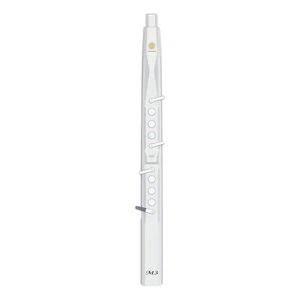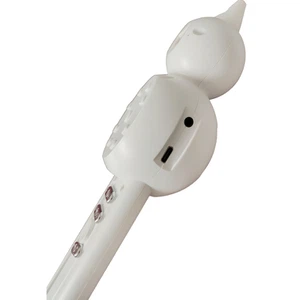The correct way of holding an electric flute is crucial for achieving optimal playing results and avoiding unnecessary strain or discomfort. Here are the detailed steps and considerations for holding an electric flute correctly.
I. Understanding the Anatomy of an Electric Flute
Before learning how to hold the electric flute correctly, it's essential to understand its basic structure. An electric flute typically consists of several main parts:
Headjoint: This is the part where the player blows air into. It contains the embouchure hole where the air is directed to produce sound.
Body: The main elongated section of the flute where the keys are located. It houses the various mechanisms that control the pitch and tone of the instrument.
Footjoint: The lower end of the flute, which can sometimes be extended or adjusted to change the pitch range.
II. Posture and Body Alignment
Sitting Posture
When sitting to play the electric flute, choose a stable chair with a straight back. Sit up straight with your back not leaning against the chair backrest. This helps maintain good posture and allows for proper breathing and instrument control.
Place your feet flat on the floor, about shoulder-width apart. This provides a stable base and helps distribute your weight evenly.
Keep your shoulders relaxed and down, away from your ears. Avoid hunching or tensing your shoulders, as this can lead to muscle fatigue and affect your playing.
Standing Posture
If standing while playing, distribute your weight evenly on both feet. Keep your knees slightly bent to provide flexibility and stability.
Align your body so that your head is centered over your shoulders and hips. This helps maintain balance and control.
Again, keep your shoulders relaxed and down, and maintain an upright posture.
III. Holding the Electric Flute
Grip on the Body
Hold the body of the electric flute with your left hand. Place your thumb underneath the flute, resting it on a support or key if available. Your fingers should curve naturally around the flute, with each finger resting lightly on the corresponding keys.
The position of your hand should be comfortable and allow for easy movement of the fingers. Avoid gripping too tightly, as this can cause tension and restrict your playing.
Support for the Right Hand
The right hand also plays an important role in holding the electric flute. Place your thumb underneath the flute, similar to the left hand. Your fingers should be positioned over the keys, ready to press down to produce different notes.
The right hand provides additional support and control, especially when playing faster passages or using more complex fingerings.
Balance and Stability
Ensure that the electric flute is balanced between your two hands. The weight should be distributed evenly, and the instrument should feel stable and secure in your grip.
Avoid tilting the flute to one side or the other, as this can affect the sound quality and make it difficult to play accurately.
Headjoint Position
The headjoint should be held at a comfortable angle, allowing you to direct your air flow into the embouchure hole easily. Experiment with different angles to find the one that works best for you.
Keep the headjoint steady and avoid moving it around too much while playing, as this can cause inconsistent sound and intonation.
IV. Breathing and Playing Technique
Breathing
Correct breathing is essential for playing the electric flute. Take deep breaths from your diaphragm, filling your lungs completely. Avoid shallow breathing from your chest, as this will not provide enough air support for your playing.
As you play, release the air smoothly and evenly, controlling the flow with your abdominal muscles. This helps produce a steady and consistent sound.
Embouchure
Forming the correct embouchure is crucial for producing a good tone on the electric flute. Place your lips on the embouchure hole, creating a small opening with your mouth. The position and shape of your lips will vary depending on your individual anatomy and playing style.
Experiment with different embouchure positions and lip tensions to find the one that produces the best sound for you. Keep in mind that a relaxed and natural embouchure is often more effective than a tense one.
Finger Technique
Use your fingers to press down the keys on the electric flute with a light touch. Avoid slamming the keys down, as this can cause unwanted noise and affect the intonation.
Practice smooth and accurate finger movements, transitioning between notes quickly and effortlessly. This requires coordination between your hands and a good understanding of the fingerings for different notes.
V. Adjustments and Fine-Tuning
Personal Comfort
Everyone's body is different, so it's important to adjust your grip and posture to suit your individual needs. If you feel any discomfort or strain while playing, make small adjustments until you find a position that feels comfortable and natural.
Pay attention to any areas of tension or pain, and address them promptly to prevent long-term injuries.
Instrument Settings
Some electric flutes may have adjustable features such as headjoint angle, key height, or strap length. Experiment with these settings to find the ones that work best for you and your playing style.
Consult the user manual or a professional flute teacher if you're unsure about how to adjust these settings properly.
In conclusion, holding an electric flute correctly requires a combination of good posture, proper hand placement, and comfortable breathing and playing technique. By following these guidelines and making adjustments as needed, you can ensure that you are able to play the electric flute with ease and produce a beautiful sound. With practice and patience, you will develop a solid foundation for your playing and enjoy the many benefits of this wonderful instrument.
SUNRISE MELODY M1 Electronic Wind Instrument
. Revisit the passion and dreams of youth
. M1 electric clarinet wind instrument -- The good news for beginners
. Rich and diverse timbres
. Powerful functions and easy operation
. Perfect after-sales service



